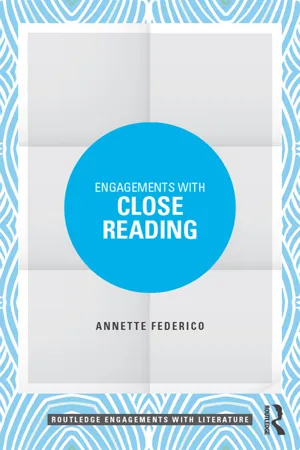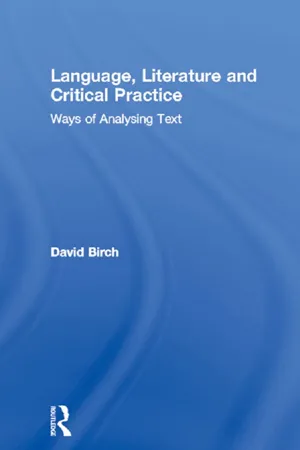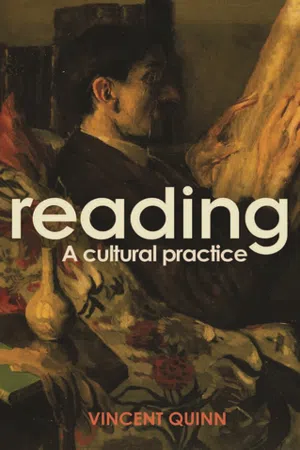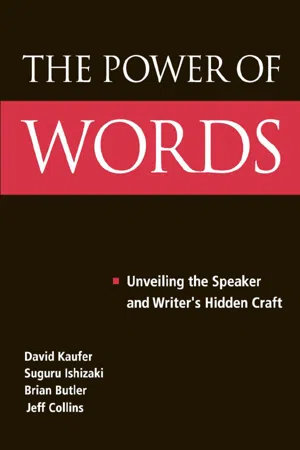Languages & Linguistics
Close Reading
Close reading is a method of literary analysis that involves examining a text in detail to uncover deeper meanings and nuances. It focuses on the specific language, structure, and style of the text, often uncovering layers of meaning that may not be immediately apparent. Close reading is a valuable tool for understanding the intricacies of language and the ways in which authors convey their ideas.
Written by Perlego with AI-assistance
6 Key excerpts on "Close Reading"
Learn about this page
Index pages curate the most relevant extracts from our library of academic textbooks. They’ve been created using an in-house natural language model (NLM), each adding context and meaning to key research topics.
- eBook - ePub
Text Complexity
Stretching Readers With Texts and Tasks
- Douglas Fisher, Nancy Frey, Diane K. Lapp(Authors)
- 2016(Publication Date)
- Corwin(Publisher)
6 Exploring Teacher-Led Tasks Closely Reading Complex Texts© Robert W. Ginn/PhotoEditSince the first edition of this book, significant attention has been focused on Close Reading. This approach to text analysis involves a reader returning to a given text more than once to analyze the language, structures, and patterns as a means to become informed about the message being shared. Close Reading isn’t a teaching strategy in and of itself. Rather, it is an approach to reading. Close Reading involves the myriad ways in which proficient readers make sense of complex text—all with the end goal of understanding what the author is doing and accomplishing, and what the information means. More specifically, Close Reading involves students identifying a purpose(s) for reading, accessing and using prior knowledge, analyzing and determining the meaning of discipline- or topic-based language, organizing and interpreting information, and refining and revising their understanding during each rereading.Close Reading as an approach to text analysis has quite a long history. Referred to as exegesis by early Greek scholars, Close Reading was the interpretative approach used to interrogate sacred texts (Juel, 1998). The idea of close text analysis surfaced again in 1929, when Richards gave his students poems and did not tell them who wrote them or when they were written. He wanted his students to concentrate on the words on the page and to derive the correct meaning from the words themselves, with no preconceived notions about the text or influences from their own lives. This insular view of text interpretation resulted in the New Criticism movement that was developed around 1930 by Empson, a student of Richards.Over the years, Close Reading has fallen in and out of favor. When the pendulum swung away from the focus on the text itself, as noted by Blau (1994), more importance was placed on a reader’s interpretation of the text: “A work of literature is an inert text that can hardly be said to have more than a potential for meaning until it is called into being by a reader who constructs a reading, thereby giving meaning to the text” (p. 26). Rosenblatt (1995) then called for a more balanced approach, noting in her discussion of reader response theory that “[t]he reader must remain faithful to the author’s text and must be alert to the potential clues concerning character and motive” (p. 11). Rosenblatt was concerned that readers might ignore elements in a text and fail to realize that they were “imputing to the author views unjustified by the text” (p. 11). Her concerns were valid with respect to the way the reader response approach was sometimes overemphasized in the classroom: too often students were encouraged to make text-to-self connections to share somewhat related personal experiences, but teachers then failed to have them juxtapose these against the text itself. In these scenarios, classmates may have responded by adding additional personal experiences, and the discussion often ended before they returned to the text. The lack of returning - eBook - ePub
- Annette Federico(Author)
- 2015(Publication Date)
- Routledge(Publisher)
Fight Club. Close Reading is essentially about understanding different levels of coherence in written communication, and this is a skill very much worth learning. In a great essay called “Reading in Slow Motion,” published in 1962, Reuben Brower argued that acourse in interpretation is a course in definition by contexts, in seeing how words are given rich and precise meaning through their interrelations with other words. The student who acquires this habit of definition will be a better reader of philosophy or law or any other type of specialized discourse, and he may learn something about the art of writing, or how to control context in order to express oneself.(1962: 11)I hope the personal and practical value of forming this intellectual habit and acquiring the skills and competencies Close Reading fosters will become apparent in the chapters to follow, as we work through some sophisticated critical positions, and explore an array of literary works.As the contemporary scholar Jane Gallop has recently argued, Close Reading is by no means a new idea in literary criticism; it was the very practice that turned English into a discipline, and it is still the most valuable thing English has to offer (2007: 183). Yet some scholars are beginning to feel that, in the last half decade or so, Close Reading skills have been crowded out of the field by a set of other practices that have tended to move away from the relational aspect of reading that I want to emphasize. Although a simplification, I think it’s fair to say that these orientations to the literary work have tended to look at determinants of the way language can be used in society (sometimes referred to as cultural discourse) and at the abstract social and political machinery that generates patterns of behavior. In this view, literature is seen as part of a socio-linguistic system. So some critics attack the job of reading a novel or a poem by interrogating certain categories supposed to be in any product of culture, such as economics or gender, looking for political and ideological assumptions that the text may have smoothed out or hidden from its original audience. The author himself is pretty irrelevant, in this view, because systems of language and technologies of writing have already determined his attitude of expression, his metaphors, his symbols, his assumptions about genre. If a view of the world is being expressed in Hamlet, it is not Shakespeare who expresses that view, but the text of the play Hamlet, an arrangement of language inextricable from other texts that came before and will come after. A similar strand in critical theory insists on the instability of language, implying that words don’t refer to anything “out there” in what we call “reality,” but only to more words; to talk about the “meaning” of a poem is irrational, since all we really have are grammatical patterns generating more grammatical patterns. A single work of literature, then, may be seen to dissolve into intertextuality - eBook - ePub
Language, Literature and Critical Practice
Ways of Analysing Text
- David Birch(Author)
- 2005(Publication Date)
- Routledge(Publisher)
3 Analysis of text therefore requires skill in language, linguistics, rhetoric, and diction. It is effectively analysis of literary texts by linguistic means.4 Although with analyses on language rather than on literary effects and devices, the view of language is still one that sees language as essentially transparent, an innocent vehicle that ‘carries’ meaning.5 The critic is therefore also considered to be innocent and disinterested, working in a supposedly objective, unbiased way and allowing the formalities of the Close Reading technique to highlight the meaning of the text encoded into it by the writer, rather than examining the institutionally determined readings of the text.6 This is, however, carried out with a much more sensitive awareness of the context and situation of the production of the text (though rarely of its readings) than intrinsic non-linguistic approaches to analysis.7 The consequence of an increased awareness of the importance of language and context in text analysis is an increased recognition that analysis is concerned not just with what a text means, but how a text ‘works’.8 With a greater emphasis on the language of the text comes a more detailed and formally rigorous argument about the ‘special’ character of literary/poetic language, because language within literature is considered to ‘draw attention to itself’.The concentration on language organization and on the distinctive characteristics of literary/poetic language developed critical practice beyond the narrower confines of Close Reading with its relatively unsystematic emphasis on rhetoric and diction. Some lin guists and critics achieved awareness of the importance of context as well as of the potential pedagogical relevance of linguistically-informed readings of texts. Others, however, saw analysis as a means of developing greater understanding of the system (langue) of language, rather than developing a specific interest in and awareness of literature and discourse. The consequences for the analysis of texts were far-reaching, emphasizing and prioritizing in particular the preoccupation for the ‘scientific’ character of twentieth-century structuralism.Chapter 5 - eBook - ePub
Reading
A cultural practice
- Vincent Quinn(Author)
- 2020(Publication Date)
- Manchester University Press(Publisher)
It emerges from broadly the same historical moment as the Leavises’ quarrel with Woolf over ‘common’ reading and, like Leavisite criticism, ‘close’ reading proclaims a ‘rigour’ and ‘seriousness’ that distinguishes it from the literary ‘appreciation’ associated with earlier academics such as Sir Arthur Quiller-Couch and Sir Walter Raleigh. Rejecting belles lettres, I. A. Richards (the key figure here) and his successors sought a scientific basis for literary analysis by bolstering their interpretations with insights drawn from psychology, linguistics, and anthropology. In doing so, they established close textual analysis as the default method of English studies. Rather than providing an intricate account of Close Reading’s influence on literature teaching, I will use this chapter to ask a more conceptual question about what it means to read a text ‘closely’. What is being staked out by commentators who make ‘close’ textual attention the gold standard of literary criticism? How close is ‘close’, and can you get too close? 2 I will begin by examining a metaphor that runs through Richards’s criticism, employing it to illuminate both the benefits and the potential limitations of Close Reading. One shortcoming is that certain interpretive traditions (notably New Criticism) have used Close Reading to evacuate literature’s social and political contexts. Another difficulty is that Close Reading can become arid when it is applied mechanistically; I will show that this is a particular danger in how literature is taught at school. As well as critiquing reductive versions of Close Reading, I want to champion a more experiential version of textual attentiveness, a paradigm of which can be found in the reading scene at the start of Jane Eyre - eBook - ePub
The Power of Words
Unveiling the Speaker and Writer's Hidden Craft
- David S. Kaufer, Suguru Ishizaki, Brian S. Butler, Jeff Collins(Authors)
- 2004(Publication Date)
- Routledge(Publisher)
see p. ). McGann’s point is that Close Reading requires noticing the language as well as interpreting it. Interpretation is a high art, visible and touted among critics. Noticing is a low craft, less visible and often hidden in theories of interpretation. Nonetheless, Close Reading requires the cooperation of the high art with the low craft. The close reader must build ties between the upstream of noticing language primings and the downstream of social elaboration. As a geologist builds bold theory from ordinary surface traces in the fossil record, the close reader understands that whatever mighty interpretations accrue downstream must at least “fit” the visible residues found upstream in the surface primings of language.Close Reading requires that deep comprehension be supported by surface-level primings. As B. R. Myers (2001) recently noted in his much-discussed “Reader’s Manifesto,” reviewers of contemporary fiction lose their credibility when they fail to tie their overall evaluations of texts to concrete prose passages. Consider strings 14 to 17, which reviewers have used to evaluate Michael Chabon’s Pulitzer Prize-Winning novel, The Amazing Adventures of Kavalier & Clay.14. It’s absolutely gosh-wow, super-colossal—smart, funny. (The Washington Post)15. A big, ripe, excitingly imaginative novel.…echoes Ragtime…suggests John Irving. (The New York Times)16. Some books you read for their plot, some for their style. When, like Chabon’s, both are exceptional, you’re in a rare place. (USA Today)17. I’m not sure what the ‘great American novel’ is, but I’m pretty sure that Michael Chabon’s sprawling, idiosyncratic, and wrenching new book is one. (The New York Times Book Review)High praise indeed. Yet, according to Myers, it is also inflated praise if the reviewer, given the space, is not able to reproduce at least some choice examples of the prose effects Chabon musters to justify it. The “what” of Close Reading, Myers suggests, should include language visible on the page. - eBook - ePub
The Languages of Literature
Some Linguistic Contributions to Criticism
- Roger Fowler(Author)
- 2016(Publication Date)
- Routledge(Publisher)
Essays on Style and Language, 10–11) it has, like other formally distinctive texts, essentially distinctive contexts which the linguist no less than the critic must study. That is, the investigator must be curious about the extra-linguistic features which condition the distinctive style of a literary work. As for the applicability of different linguistic models, this is obviously variable. The old Bloomfieldian linguistics in its classic Immediate Constituent analysis phase, or Hallidayan scale-and-category grammar, both concentrating on relatively ‘small’ units, can have little to say about the linguistic structure of extended texts. Nor can we expect to learn much through linguistics about kinds of poetry where metaphor is dominant until we have proper tools for lexical analysis. It apparently needs repeating over and over again that there is no one linguistics providing a ready-made set of procedures or formulae perfectly apt for all kinds of texts. The appropriateness of the model is a concern for the individual analyst; just as important for this general discussion is that all those who engage in it realize that bland undefined accounts of ‘linguistics’ lead nowhere. There is no one linguistics except in community of certain basic and general ideals held since Saussure’s time. We cannot switch on a standardized linguistic analysis machine and stand by while it puts out a definitive breakdown of a text. Doubtless the lack of such a de vice has its advantages.My third prescription for a successful linguistic criticism is that it should proceed not merely from a theory of language but also from a respectful consideration of the demands and peculiarities of the many kinds of literary study. Now, the substance of this remark is addressed not only to linguists. There is no single thing ‘criticism’ any more than there is ‘linguistics’, although literary people, faced with the imagined threat of linguistics, tend to talk as if there is. (This impression is gained partly from the tendency to use ‘criticism’ and ‘critical’ as treasured value terms.) I am not talking here of diversity of critical school, the sort of thing hilariously dramatized in The Pooh Perplex, but of different purposes in the discussion of literature. In the real world, we are dealing with, above all, teachers of literature whose pedagogic relations with their subject-matter and with their students are much more vital than the role of the public critic. Most often literature teachers are involved in nothing more mystical than, at various degrees of sophistication, showing the ways to efficient reading of literature. Many a time literary study comprises historical, stylistic or openly technical investigation: genre description, stylistic tests of authorship, metrical analysis, for example. For some reason, ‘interpretation’ (an exceedingly difficult term) and ‘evaluation’ have come to be regarded as the only activities which are worth doing and which are actually done. Just as we need to be wary in our use of ‘linguistics’ as a term describing all procedures involving the study of language, so we should give careful scrutiny to terms like ‘criticism’, ‘interpretation’, ‘evaluation’, ‘explication’, ‘stylistics’, ensuring that we do not think that there is just one objective (of whatever kind) in studying literature, with ‘linguistics’ straightforwardly an alternative ‘technique’ for reaching that goal.2





